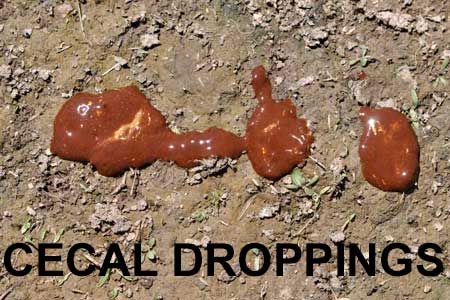
Chicken diarrhea is often called enteritis, but the two words are not synonymous. Enteritis is inflammation of the intestines. One sign of enteritis is diarrhea. On the other hand, diarrhea has other causes besides enteritis. For practical purposes, though, the two words are often interchangeable. Whether the result of enteritis or something else, trying to determine what causes diarrhea in chickens can be difficult.
Signs of Diarrhea in Chickens
Chicken diarrhea consists of droppings in which the fecal portion is too loose to retain its shape. In other words, the poop is soupy or watery.
Diarrhea is usually accompanied by dehydration and increased thirst. Other indications include loss of appetite and general weakness. Diarrhea results in slow growth in young chickens and weight loss in mature chickens.
Causes of Chicken Diarrhea
Diseases that cause diarrhea in chickens tend to be complex. Combinations of and interactions among various organisms determine the severity of the condition.
Successful treatment therefore requires knowing what organisms, or combination of organisms, are causing the condition. Here are some of the most likely causes of diarrhea in chickens:
- Bacteria causes omphalitis in chicks, colibacilosis in young birds, paratyphoid in mature chickens, and tuberculosis in aging chickens. All chickens are susceptible to infectious coryza and staphylococcosis.
- Viruses cause infectious bursal disease and Marek’s disease in young chickens and lymphoid leukosis in mature chickens. All chickens are susceptible to infectious bronchitis, low pathogenic avian influenza, and endemic Newcastle disease.
- Parasites cause these diseases that result in diarrhea: coccidiosis, intestinal cryptosporidiosis, and roundworms, all of which generally affect young chickens.
- Yeast infection causes sour crop, which typically affects either young chickens or aging chickens.
- Cloacitis (also called vent gleet) is characterized by smelly diarrhea sticking to vent feathers. It is not a specific disease, but a condition that itself is caused by many things, including bacteria, fungi, yeast, protozoa, and parasites.
Sometimes you can identify a disease by looking up the signs in a reliable source. But, since many chicken diseases have look-alike signs, you might need to consult a veterinarian or your state’s poultry pathology laboratory for a definitive diagnosis.
When It’s Not Diarrhea
Not all soupy poop is diarrhea. For instance, cecal droppings (pictured here) are not diarrhea. Also, some medications can loosen the consistency of a chicken’s poop without resulting in full-blown diarrhea.
A chicken occasionally produces excess liquid urates, the chicken’s equivalent of urine. These extra urates dilute the solid feces, resulting in a condition that may look like diarrhea.
Stress often induces a chicken to produce more urates than usual. Chasing or suddenly grabbing a chicken can trigger the release of a squirt of runny poop.
In hot weather, chickens drink a lot of water that produces more urates than usual. Eating a lot of juicy fruits or vegetables also produces excess urates. Such droppings often appear as a pool of liquid surrounding solid matter that’s slightly greenish in color.
So when a chicken’s poop looks a bit runny, don’t panic. Analyze the situation and start first with the easiest answers to what causes diarrhea in chickens.
And that’s today’s news from the Cackle Coop.
Gail Damerow is author of The Chicken Health Handbook.

